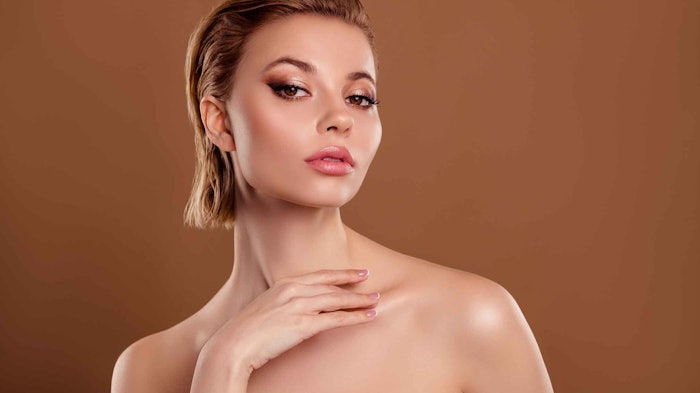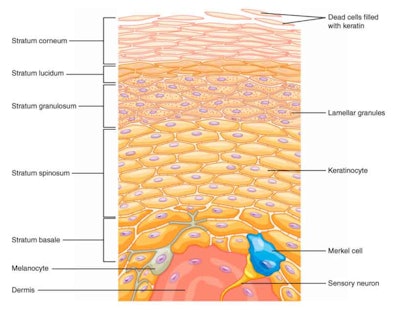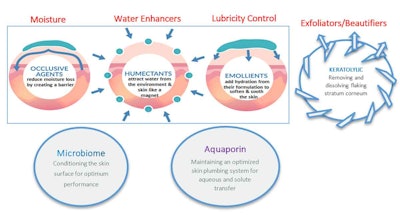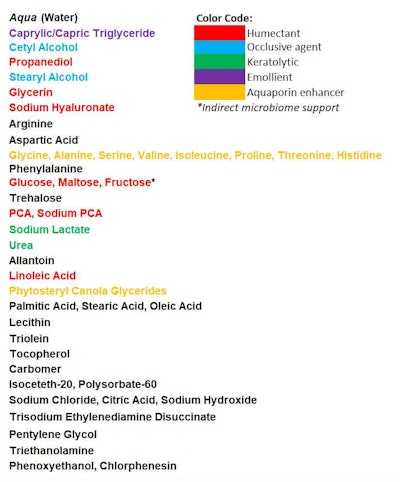
Skin moisturization – what does this really mean? To some, it is about beautification, meaning the look and feel of skin. To others, it means optimizing skin health and maximizing improvements and the maintenance of it; i.e., repairing imperfections and damage to the skin by what might be considered pseudo-pharma-therapeutic cosmeceuticals.1
Log in to view the full article
Skin moisturization – what does this really mean? To some, it is about beautification, meaning the look and feel of skin. To others, it means optimizing skin health and maximizing improvements and the maintenance of it; i.e., repairing imperfections and damage to the skin by what might be considered pseudo-pharma-therapeutic cosmeceuticals.1
Various terms, such as moisturizer, humectant, occlusive agent and exfoliant, have been used to define moisturization. So, to address its maximization in skin, it is important to understand differences in the science behind each – in addition to the synergistic balance of key ingredients and benefit categories. This will sharpen our formulating skills to create products capable of strengthening the skin barrier, allowing the epidermis/dermis to operate more effectively and resulting in naturally healthy skin. This, in turn, will give the end user a “reason to believe” thanks to results-oriented, observable results.
This article explores the building blocks of skin and aspects that can be targeted to improve its temporary and sustained health. It also elucidates how to achieve these goals with key ingredients, serving as a primer or refresher of the basics behind a good moisturizer formula.
The Skin’s Perspective
The focus of this discussion is on products topically applied to skin, so it will concentrate on the stratum barrier and optimizing its repair to maintain proper moisture modulation – the theory being that re-balancing the skin’s moisture content will allow the barrier to repair itself naturally. This would not only improve barrier health, but also require less maintenance and sustained rebuilding/maintenance of the sub-stratum corneum (see Figure 1).2
 Figure 1. Depiction of skin layers and structuresimage courtesy of E. Abrutyn
Figure 1. Depiction of skin layers and structuresimage courtesy of E. Abrutyn
The notion of improving the skin’s healthy barrier (stratum corneum) was proposed by Jacobi, et al., in 1958 with the establishment of the natural moisturizing factor (NMF) concept.3, 4 It was based on the theory that by removing key epidermal-forming, water soluble stratum corneum compounds decreased the skin’s water-binding capacity.
Jacobi postulated that adequate hydration, via improved stratum corneum plasticity, improved natural desquamation through hydrolytic enzymes, thus optimizing barrier function. This helped to modulate internal versus external moisture content, restoring the nature of skin – representative of the stratum corneum, dermis and hypodermis.
The composition of NMF includes free amino acids, e.g., pyrrolidone carboxylic acid (PCA); lactic acid; urocanic acid, a natural UV light absorber; inorganic acids/salts and organic acids/salts based mainly on sodium, potassium, calcium, magnesium, chlorides, phosphates and citrate; peptides; sugars; urea; citrate; glycerol; and others. The average natural moisturization factor (NMF) comprises, approximately:
- 40% Amino acid,
- 12% PCA,
- 12% Lactate salt,
- 7% Urea,
- 1.5% Glucosamine/creatinine,
- 0.5% Citrate salts,
- 18.5% Sodium, potassium, calcium, magnesium, phosphorus and chlorine, and
- 8.5% Sugars, organic acids and peptides.
In the 1970s, the present author was first introduced to the NMF concept as he was working on a library of branched chain “porosity” esters. This led to his development, in the late 2000s, of the idea of a moisture-building reservoir – where the surface atmospheric moisture/humidity is modulated and balanced against the loss of moisture in the epidermis (stratum corneum), therefore optimizing the sub stratum corneum moisture content to create an environment for the natural maintenance of healthy skin. In other words, the author’s hypothesis was to engineer a properly balanced mix of key ingredients to mimic what Jacobi discovered in the 1950s – which is explored in the next section.
Formulating for Skin Health: The 4+2+1 Theory
Formulating an ideal balance of ingredients for skin health initially began with an approach using four ingredient types to address what has been referred to as the “4 Key Elements of Skin Moisturization.”5 These include: humectants, emollients, occlusive agents and keratolytic agents.
Advancing from the concept of skin moisturization to health, two biological considerations were later added to the approach – aquaporins and the microbiome – along with one additional ingredient type, an anti-inflammatory agent. This resulted in what is now referred to as “4+2+1 Key Elements to Healthier Skin."5
The various ingredient types serve specific functions (see Figure 2):
- Humectants are balanced in combination as moisture modulators;
- Emollients impart aesthetic properties and can plasticize skin, making it more pliable;
- Occlusive agents, including both linear and branched, create the right amount of film porosity;
- Keratolytic agents remove dead surface cells to rejuvenate the stratum corneum;
- Aquaporin enhancers act on cellular aquaporins that act as an effective moisture transport system, maintaining healthy corneocyte and keratinocyte populations that eventually form the stratum corneum;
- Microbiome support ingredients to maintain a healthy skin environment – this area is a relatively new consideration and described in more detail later; and
- Anti-inflammatory agents to reduce inflammation and deleterious sensitivity in compromised skin.
The next section will look at each of these key 4+2+1 elements, followed by a brief guide to efficacy testing and examples of commercial formulas that use this theory to improve skin health.
 Figure 2. The various ingredient types serve specific functionsimage courtesy of E. Abrutyn
Figure 2. The various ingredient types serve specific functionsimage courtesy of E. Abrutyn
Humectants
As stated, humectants in skin care are most noted for their ability to absorb moisture/humidity. They draw water to skin cells to keep the skin hydrated. Humectants act as a good first layer of moisture and are suitable for all skin types, including oily, combination and acne prone because they are devoid of heavier oils. Humectants are best used for dry, thick skin and in climates that are very humid or ultra dry. Key examples include glycerin, lactic acid, urea, hyaluronic acid and alpha hydroxy acid (AHAs).
Emollients
Emollients can be considered space fillers and skin aesthetics enhancers. They fill in any spaces or gaps between skin cells where moisturizing lipids are missing, making skin smoother and better hydrated. They also act as good plasticizers for the skin, enhancing its pliability and plushness. Emollients are usually oil-based but can also be water-based; examples include lanolin, mineral oil, petrolatum and C30-45 alkyl dimethicone.
Occlusive Agents
Occlusive agents modulate and seal in moisture. Designed to douse the skin in moisture, they are heavier in nature and usually recommended more for body skin than facial skin.
These ingredients work best for mature, dehydrated skin that is void of an environment with any humidity. They are not recommended for skin that is reactive or blemish prone. Examples include rose hip, avocado, coconut, mango and hazelnut oils.
Keratolytic Agents
Encouraging desquamation, keratolytic agents are natural skin rejuvenators for the stratum surface. They slough off dead cells and stimulate the dermis to generate a fresh stratum corneum layer, thus supporting the renewal of damaged or compromised stratum corneum. This takes ingredient functionality to the next level, with activities to maintain and repair the skin barrier. Example keratolytic agents include natural hydroxy acids, glycerin, hydrolyzable lactates (e.g., lactamide MEA), urea, PCA and its derivatives, and small particulates such as coffee grounds and fruit nut powders.
Putting these first four elements in action, to address facial skin dryness, a combination of humectants and keratolytic agents would be recommended. To remove dry white scales from the legs, again, a combination of keratolytic agents and humectants would be beneficial in addition to emollients to improve the initial skin feel and denote skin softness/smoothness. If skin on the hands feels rough and tight, especially during cold and dry winter months, a balanced combination of humectants, occlusive agents and emollients will improve the skin’s barrier to reduce trans-epidermal water loss (TEWL) while providing a soft and smooth skin feel through the plasticization of the stratum corneum.
Aquaporin Enhancers
Aquaporin enhancers, as noted, were a later addition to the proposed hypothesis. Aquaporins are mostly located in the corneocyte region6 and are effectively the plumbing system or water channel controls for cells. They form a larger family of intrinsic proteins that create pores in the membranes of biological cells.
Aquaporins allow for the efficient and organized movement of water through cells, transferring water and other small solutes between cells in the skin through membrane proteins. They also prevent the passage of ions and other solutes.
Aquaporin enhancers include aqua-glyceroporins that transport other small, uncharged dissolved molecules, such as glycerin; urea; gluco-glycerol; blue-green algae, which can stimulate the native aquaporin network; retinoids, which can stimulate the production of aquaporin by nearly 1,000% (e.g., retinaldehyde); and caffeine, which also stimulates the production of AQP3 proteins. In relation, ingredients that “feed” a person’s natural microbiota and maintain a healthy balance, described next, can establish a healthy skin surface that allows skin’s natural transport behaviors to be maintained.
Microbiome Support Ingredients7, 8
Another late addition to the 4+2+1 formula – and emerging subject of interest to skin health – is the microbiome. Natural skin microbiota primarily include bacteria, fungi and viruses that protect against invading pathogens that can compromise our natural immune system. The microbiome comprises all the genetic material within the entire collection of microbiota in a specific niche, such as the skin or gut. It is unique to each person and can vary over time or based on external stimuli or contamination. For additional insights on the skin microbiome, see Lawrence.
Variations in the microbiome have been linked to adverse skin conditions such as atopic dermatitis, dandruff, acne and sensitivity. Therefore, it is key to maintain the normal healthy skin microbiota as opposed to introducing new biota that could interfere with functional skin microbiota and exacerbate negative effects. Ingredients have been developed to support the skin’s microbiome; for example, those that improve natural hydration and water transport along with improved glycerol mobility. No doubt new solutions will emerge, as this field is still in its infancy.
Anti-inflammatory Agents9
Anti-inflammatory agents are the final addition to the skin health formula. Consider: the stratum corneum is a permeable barrier. For the six key ingredient types described to be effective, it must allow them access but also prevent contaminants from entering that can compromise the integrity of the skin barrier.
Inflammation takes place in response to damage to the normal skin barrier, and external or internal inflammatory compounds can easily compromise the barrier, causing a vicious cycle. Antagonistic stimuli can also include injuries, wounds and/or infections, leading to inflammatory dermatoses, skin aging or skin carcinogenesis.
To counteract or reduce the inflammatory response, anti-inflammatory agents can therefore be used. Examples include aloe vera, chamomile, cannabidiol, triterpene glycoside, glycyrrhizin and miscellaneous plant oils and extracts. The key is that the active is present in sufficient levels and the use level corresponds to effectiveness.
Guide to Substantiating Moisturization Claims
Before building a formulation, it is important to consider how to measure whether it delivers the desired moisturizing effect via the key elements described. This is generally achieved through clinical testing. The present article will not discuss clinical testing in depth but for reference, below are five test methods worth exploring to establish delivered performance benefits.
Regression challenge test: A seven-day regression challenge test is recommended following the protocol:
- Day 1: initial baseline test is established and product is applied;
- Days 2-4: product is reapplied;
- Day 5: tests performed at baseline (Day 1) are repeated;
- Days 5-7: no product is applied; and
- Day 8: tests performed on Day 5 are repeated to look for any degree of regression. Here, minimal or no change shows the treatment demonstrates extended skin health improvements.
Trans-epidermal water loss (TEWL): TEWL measures the occlusive action of water as it migrates to the surface of skin. Notably, occlusive films (e.g., petrolatum) can disguise the real health of skin because they create an occlusive barrier and reduce the ability to predict the actual transpiration rate of moisture evaporation from the stratum corneum.
Conductance: Conductance, or Galvanic skin response, measures the electrical changes (resistance) of skin due to the water-binding capacity of the stratum corneum. Hydrated skin produces a conductance; more water leads to an increased conductance and decreased impedance.
Observer dryness: Skin dryness is both an objective indication of the appearance of skin (via trained clinicians) and subjective indication of the skin’s healthy look (via consumer self-scored observations). Both are good ways to predict and match the consumer’s expectations of stated claims.
Desquamatry: Finally, desquamatry assesses the degree of flaking and scaling on skin. Here, adhesive discsa are used to collect samples and are both visually scored and stained for color evaluation (squamometry) with a colorimeter (C* value). A good way to determine if dry skin is alleviated is to look for the degree of reduction in flaking on the skin after treatment.
Building 4+2+1 Formulas: Commercial Examples
Effective moisturizing formulas built on the 4+2+1 concept for skin health are demonstrated by several commercial examples. The brand The Ordinary, for example, even uses NMF in the name of one of its products: Natural Moisturizing Factors + HA. The ingredient disclosure for this product is shown in Table 1, color coded for illustrative purposes to indicate the 4+2+1 function of each ingredient (where applicable).
 Table 1. Natural Moisturizing Factor Product Disclosure
Table 1. Natural Moisturizing Factor Product Disclosure
Comparing these ingredients to the key 4+2+1 elements, it should be noted that some ingredients can transcend more than one element. For example, glycerin is a humectant but also supports corneocyte aquaporin health. In 2005, it also was reported to act as a suitable keratolytic agent to dissolve flaky skin.10 Allantoin and lecithin can be considered calming skin-soothing agents, and trehalose has been reported to protect cells against desiccation.
The microbiome elements are the indirect supports glucose, maltose and fructose, which create a healthier environment for microbiota.
Other commercial examples include: SkinCeuticals’ Triple Lipid Restore 2:4:2 anti-aging lipid replenishment treatment; Origins’ Ginzing brightening eye cream; and Strivectin’s Lactic Acid Nightly Retexturizing Serum. Full ingredient disclosures (not color coded) are provided in the Anti-aging Lipid Treatment, Brightening Eye Cream and Night Retexturizing Serum sidebars (see below).
Summary
Moisturization is a critical balance between the consumer’s perceived changes in skin and the clinical validation of those changes to ensure claims are substantiated and results match consumer expectations. Overall, healthy and moisturized skin is a function of the stratum corneum barrier. The goal is to make this barrier stronger and thicker (within reason) and to support the skin’s natural moisture-balancing/modulating system to rejuvenate the innate healing process.
Formulas that achieve this are based on combinations of ingredients with different functions that follow the 4+2+1 concept described – namely humectants, occlusive agents, emollients, keratolytic agents, aquaporin enhancers, microbiota supporters and anti-inflammatory ingredients. Together, these actors define the generic term moisturization.
a D-Squames, Clinical and Derm (formerly CuDerm)
References
1. The Derm Review. (2022, Dec 5). Is your skin’s moisture barrier compromised? Here’s how to tell – and how to fix it. Available at http:/ thedermreview.com/skins-moisture-barrier
2. OpenStaxCollege. (2013). Anatomy and physiology. The Integumentary System. Layers of the Skin. Available at http:/pressbooks-dev.oer.hawaii.edu/anatomyandphysiology/chapter/layers-of-the-skin
3. Jacobi, O.K. (1959). About the mechanism of moisture regulation in the horny layer of the skin. Proc Sci Sect Toilet Goods Assoc. 31 22-4.
4. Laden, K. and Spitzer, R. (1967). Identification of a natural moisturizing agent in skin. J Soc Cosmet Chem. 18 351-60; available at https://tinyurl.com/3d3r9mmc
5. Abrutyn, E. (2022, Feb 4). Understanding the 4 key elements of skin moisturization. Wiley. Available at https://onlinelibrary.wiley.com/doi/10.1002/9781119676881.ch17
6. Verkman, A.S. and Mitra, A.K. (Accessed 2023, Oct 26). Structure and function of aquaporin water channels. American Physiological Society. Available at https://journals.physiology.org/doi/full/10.1152/ajprenal.2000.278.1.F13
7. Callewaert, C., Knödlseder, N., Karoglan, A., Güell, M. and Paetzold, B. (2021, Jan 4). Skin microbiome transplantation and manipulation: Current state of the art. Computational and Structural Biotechnology Journal. Available at https://pubmed.ncbi.nlm.nih.gov/33510866/
8. Grice, E. (2011, Aug). The skin microbiome. Nature Reviews Microbiology. Available at https://pubmed.ncbi.nlm.nih.gov/21407241/
9. Pandel, R., Poljšak, B., Godic, A. and Dahmane, R. (2013, Sep 12). Skin photoaging and the role of antioxidants in its prevention. ISRN Dermatology. Available at https://pubmed.ncbi.nlm.nih.gov/24159392/
10. Abrutyn, E.S., et al. (2005, Nov/Dec). Ability of moisturizers to reduce dry skin and irritation and to prevent their return. J Cosmet Sci. 56 427-444









